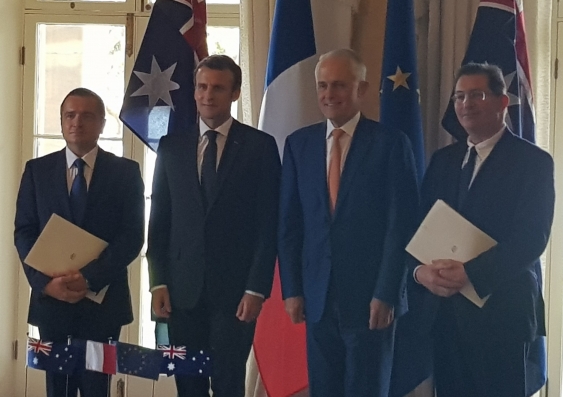UNSW partners with French organisations to strengthen innovation
UNSW has signed new agreements with French colleagues to bolster renewable energy innovation and environmental research.
UNSW has signed new agreements with French colleagues to bolster renewable energy innovation and environmental research.

Louise Caldicott
UNSW External Communications
0435 800 395
l.caldicott@unsw.edu.au
UNSW Sydney has signed new agreements with two French scientific organisations that will bolster cooperation over renewable energy innovation and environmental research.
During the ceremonial signings at Kirribilli House, UNSW Vice-Chancellor and President, Professor Ian Jacobs, signed agreements with:
“The successful partnerships UNSW enjoys with leading French science agencies place Australia and France at the forefront of collaborative research and innovation,” Professor Jacobs said. “[The] new agreements are further evidence of our commitment to work together on scientific advances which will have a positive global impact.”
The Memorandum of Understanding (MOU) with CNRS positions France and Australia as leading partners in sustainable energy innovation, particularly solar energy. Under the terms of the agreement, UNSW and CNRS will facilitate the exchange of solar energy innovations through joint conferences, seminars and research projects. Potential topics include solar energy, storage of renewable energy and renewable energy integration.
The agreement reflects the commitments of Australia and France to address climate change through the COP21 Paris Agreement and support for the recently formed International Solar Alliance, headquartered in Delhi, India.
Professor Mark Hoffman, Dean of UNSW Engineering, said the agreement between UNSW and CNRS built on the existing relationship and emphasised both parties’ commitment to sustainable energy innovation.
“UNSW Sydney welcomes the continued collaborations with CNRS to promote cooperation in the field of solar energy,” Professor Hoffman said. “We believe this partnership will lead to new and more efficient ways of delivering solar energy to combat soaring energy demands across the globe and help fight climate change.”
Through a Letter of Intent, UNSW Canberra Space and CNES will partner to study a breakthrough remote-sensing satellite that will be capable of monitoring the health of the coral reefs near Australia and in the South Pacific.
The joint study will pave the way for developing disruptive space technologies such as hyperspectral remote sensing, onboard processing, artificial intelligence and formation-flying technologies.
These technologies can serve applications such as monitoring fresh and marine water quality and enabling precision agricultural practices.
Professor Russell Boyce, Director of UNSW Canberra Space, said France and Australia had a strong legacy of space cooperation over 35 years and this project would see that relationship continue.
Professor Boyce said that after two years of working with CNES toward the development of joint space missions, it was gratifying to see the first project come to fruition.
“Our facility at UNSW Canberra enables spacecraft design engineers and scientists to rapidly design and determine the technical and economic viability of proposed space missions,” Professor Boyce said. “Our capability includes hyperspectral remote sensing and the onboard processing needed to turn measurements into useful information with real-world application.”
In addition to the two agreements, Silicon Quantum Computing Pty Ltd (SQC) and the Commissariat à l'Energie Atomique et aux Energies Alternatives (the CEA) announced plans for a new collaboration between Australia’s first quantum computing company and the world-leading French research and development organisation. SQC’s shareholders include the Australian government, UNSW, the Commonwealth Bank of Australia (CBA), Telstra and the NSW state government.
The Memorandum of Understanding outlines plans to form a joint venture in silicon complementary-metal–oxide–semiconductor (CMOS) quantum computing technology to accelerate and focus technology development, as well as to capture commercialisation opportunities – bringing together French and Australian efforts to develop a quantum computer.
The 2018 Australian of the Year and SQC director and founder, UNSW Scientia Professor Michelle Simmons, said quantum computing promised to revolutionise the IT industry.
“We have phenomenal leadership in silicon quantum computing across a range of platforms, and SQC is now moving rapidly to commercialise all these technologies,” said Professor Simmons. “It is very exciting that Professor Andrew Dzurak and his team have found a design, development and fabrication partner the quality of the CEA.”
Under Professor Dzurak’s stewardship, SQC has world-leading expertise in designing and demonstrating components of the quantum chip, based on silicon-CMOS technology.